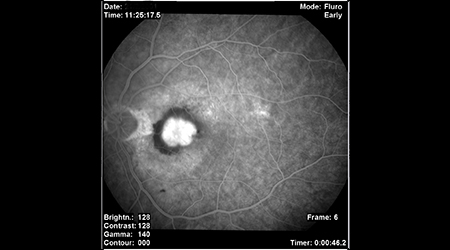Ophthalmological decision support

Fluorescein angiographic image of subretinal neovascularisation in exudative age-related macular degeneration.
Chronic retinal diseases such as diabetic retinopathy and age-related macular degeneration imply that the patients are examined repeatedly, either as part of a screening programme or in a control programme after treatment. The examination intervals are set to a fixed time, which minimized? in order to ensure the disease progresses significantly between the examinations. This conservative definition of control intervals implies that in the majority of patients there is no significant disease progression between individual examinations. Therefore, new decision support systems are being developed that allow an individualisation of examination intervals on the basis of each patient's individual risk factors. The study has shown that the examination interval can be considerably extended during screening for diabetic retinopathy, thereby reducing the costs for the health care system and the patient. Efforts are ongoing to improve the algorithms further and to extend the experience to control of AMD patients receiving intravitreal angiostatic treatment.
Reference:
Mehlsen J, Erlandsen M, Poulsen PL, Bek T. Identification of independent risk factors for the development of diabetic retinopathy lesions requiring treatment. Acta Ophthalmol 2011;89/6:515-21
Contact:
Professor Toke Bek
Phone: +45 7846 3223
E-mail: toke.bek@mail.tele.dk